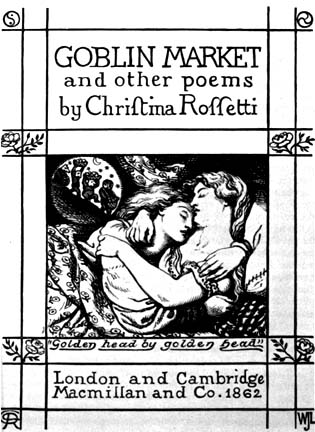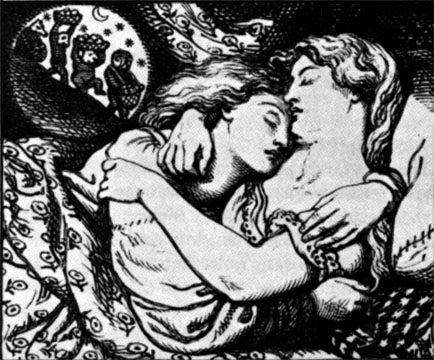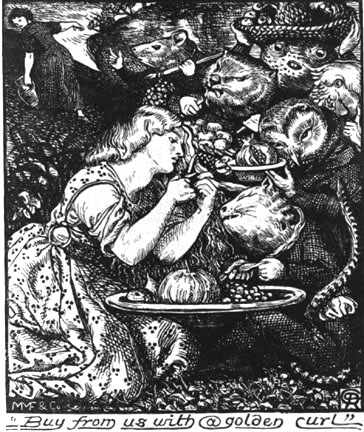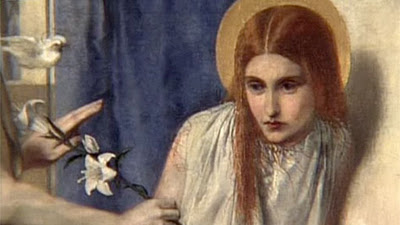Serendip is an independent site partnering with faculty at multiple colleges and universities around the world. Happy exploring!
Notes Towards Day 2 (Th, Jan. 19): From Dinner Party to Goblin Feast


should/not Christina Rossetti have a place @ the feminist table?
I. but first: welcome back....!
coursekeeping: reviewing the logistics of
how we're going to work together this semester
* did y'day's internet black-out affect you @ all?
are you taking a stand/signing the petition?
* how has the Serendip registration been going?
also! this handy left-hand tool bar will serve most of your group needs!)
sign in sheet: with your username (doesn't have to be your "real" one;
remember the three faces of Sojourner Truth;
none of "real" = aligned w/ her own calling cards;
it might be fun for each of us to choose a famous feminist as avatar--
for inspiration, see Which Western feminist icon are you?)
(if you weren't here Tuesday, also sign up w/ other identifiers....)
* instructions for weekly postings --by 5 p.m. on Sunday evening
post on-line your initial "ruminations" about the food
you've been fed so far, your thoughts about my
invitation to our dinner party --> potluck, and/or about
the "fruit-call" Laura and Lizzie heard in "Goblin Market,"
or our conversation thereon, or related topics (links,
articles, convos in other classes/places/praxis sites/
political actions....)
for Tuesday's class, read all of Virginia Woolf's 1939
tri-partite essay, Three Guineas; rpt. Mariner, 2006;
also on ebooks@Adelaide. 2009.
the conceit of the essay is that Woolf's been asked to make some contributions
(very class-specific: she has money to give!):
she gives 1 guinea to a women's college,
1 to a women's professional organization,
and 1 to work against war (a pacifist organization),
and explains why each contribution necessitates the next;
come to class ready to say where you'd give
your 3 guineas (if you had 'em), and why....
other questions/concerns/thoughts/responses re: course requirements?
Alex had one about the final performances (not to worry....)
shape of this course responsive to who's here;
also if we're going to have interactive conversations,
we need to know one another's names....
so go 'round: name yourself and the person you
invited to our Feminist Dinner Party on Tuesday:
who did you put @ the table? (why?)
next week, I may ask you to say "which feminist icon you are"....
III. my choice was Christina Rossetti, "golden head by golden head..."
I will of course soon tell you why, but let's find out first what your experience
was of this text: how it "felt," reading it, what you "thought" of it ...
and then we'll do some further shared reflection on its meaning(s)
let's start by reading some of it aloud (while eating grapes!)
take a few moments, pick the most striking (sensuous?
pleasing? troubling?) passage you can find...
and then move to the center to read it....
let's get the sound of the poem in our mouths and ears

from the course homepage:
“…feminism has already made a difference…. On the other hand, that difference has opened up and brought into view the energies of contradiction hidden inside the unsayability of what feminism has now given voice to. Once women begin to speak, we begin to differ with each other….
literature is important for feminism… as the place where impasses can be kept and opened for examination, questions can be guarded and not forced into a premature validation of the available paradigms. Literature… is… a mode of cultural work, the work of giving-to-read those impossible contradictions that cannot yet be spoken." (Barbara Johnson: The Feminist Difference: Literature, Psychoanalysis, Race and Gender, 1998)
Not monolithic, prescriptive, conformist or singular, contemporary feminist theory covers a wide range of perspectives and approaches, which this class will showcase.
Why I'm offered an introduction to "Critical Feminist Studies" as a LITERATURE course: it reflects my bias "for the exploratory over the prescriptive, for storytelling over argument or exhortation, for speculation over certainty, and for imagination over analysis" (from The Norton Book of Nature Writing--> no advocacy, prophecy, apocalypse)
break into groups of four (count off by....5's? 6's?)
to discuss some of the complexities of this poem:
* what do you think are the current issues that feminism is (or should be) addressing?
* (the "feminist icon" page asks "what is the most important feminist issue"?)
* what is your understanding of the *subject* of feminism?
(does it focus on women as physical, economic, imaginative, spiritual, beings?
as individual, social, entangled, ecological beings? )
* what is your understanding of its mode of interpretation? of action/activism?
* what does any of this have to do w/ you?
* would you call yourself a feminist? (why/why not?)
* can your group create a shared definition of the term?
(or offer a range of disagreeing ones?)
* where do you see any of these issues/modes present in this poem?
* what might poetry (more generally, as a "genre"; more specifically,
as a 19th c. English literary form) have to do w/ feminism?
* what about fairy tales/nursery rhymes (for adults, over the heads of children?)
* what about "appetite" (general or specific)?
* does Christina Rossetti "belong" @ our potluck? why/why not?
reporting back, in backwards order:
* does she belong?
* how does her poem "work" as a feminist text?

Christina Rossetti was an Englishwoman of Italian heritage who lived from 1830-1894;
she was a generation younger than Sojourner Truth 1797-1883);
"Goblin Market" was published in 1862,
a year before HBStowe's article about ST appeared in the Atlantic Monthly,
two years before she met w/ President Abraham Lincoln-->
lives as different as can be (invite you to imagine what might have been
happening in the lives of women in other parts of the world:
while Rossetti was imagining the emotional/sensual lives of women,
and STruth their right to their own labor, what might have been happening
in South America? Africa? Asia....?)
and she was the model for the Virgin Mary in the painting ‘Ecce Ancilla Domini’
(The Annunciation), 1849-1850, by her brother Dante Gabriel Rossetti.
 |
 |
it's very sensuous, sexual poem, a fairy tale about temptation....
MAYBe about lesbianism, MAYBe about eating disorders...
certainly about women's appetities, in general
not by ANY conception of the imagiantion a "major" text,
but I justify my choice both because it introduces the topic of desire, of (sexual?) appetitie,
and because it brings poetry in to the syllabus (what is feminism w/out poetry?...
anarchist Emma Goldman: "If I can't dance I don't want to be in your revolution" )
along w/ the sexism, classism and racism of much of the feminist canon
(for a taste, study the current debates about transgenders @ women's colleges....)
Wollstonecraft, Mills, Fuller, etc. take the masculine life as the point of departure,
presume as their object an equal relation BETWEEN the sexes,
and do not imagine a life which is not lived in relation w/ men;
I chose "Goblin Market" in part because it does.....
critics have offered a range of readings:
1) cautionary tale about the dangers of curiosity (Eve, Pandora)
2) or about dangers of being female:
in world which treats women as commodities,
vulnerable to sexual/economic explitation
3) spiritual fall into self-indulgence, sensuousness, w/ redemption (Adam/Eve/Satan)
(and/or for the viirtuous Anglican women who worked w/ them?)
4) sexual harrassment/physical abuse
carnal, erotic nature of bolings, of fruit that tempted "Eve"
the metaphoric gang rape, molestation, force feeding of Lizzie
in which juices that stream over her are either goblin semen,
or blood from her ruptured hymen? ("dripping pitcher")
5) homoerotic
appetite puts women @ risk:
orgiastic feast of sister's body in which "stronger fire overcomes desire"
Laura feeds on Lizzie, and so gets a passionate antidote to deadly sex w/ men
6) female heroism (of the nurturing sister)
entwined after the fall: serene end--female potency, happiness; men absent
integration of a divided self: self-indulgence/renunciation
7) consumption disorders
looking @ food not as metaphor for sex, but as sensuous in its own right
eating disorders began to be noticed in the 1850s; were labeled, diagnosed in the 1870s,
when food preparation began to give way to marketing, when food was first available in excess
(read from today's terms: heoric anoxeric Lizzie starves self for bilumic Laura)
8) mercantile/economic reading, focusing locus in the market
consumer culture produces/controls desire:
Lizzie is successful because she refuses to be a consumer
is w/out desire for the product
moral here: market is dangerous to maids who belong @ home
(cf. self sufficiency of food preparation)
poem not just a feminist guide to shopping, but critique of capitalism:
mothers vs merchants (see work on "separate spheres," private vs. public)
questioning "fruits of empire": luxry imported gourmet foods,
come to England thorugh colonialism, exploitation of poor in other countries
(Uncle John Polidor, The Vampyre, 1819]
| spiritual fall | ||
| sexual dimensions | economic dimensions | |
| sexual harrassment/physical abuse | critique of capitalism | |
| homoerotics | ||
| female heroism | ||
| eating disorders |


